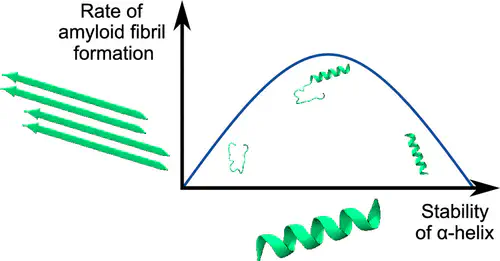The Kinetics of Amyloid Fibrillar Aggregation of Uperin 3.5 Is Directed by the Peptide's Secondary Structure
 Graphical Abstract: ACS
Graphical Abstract: ACSAbstract
Many peptides aggregate into insoluble β-sheet rich amyloid fibrils. Some of these aggregation processes are linked to age-related diseases, such as Alzheimer’s disease and type 2 diabetes. Here, we show that the secondary structure of the peptide uperin 3.5 directs the kinetics and mechanism of amyloid fibrillar aggregation. Uperin 3.5 variants were investigated using thioflavin T fluorescence assays, circular dichroism spectroscopy, and structure prediction methods. Our results suggest that those peptide variants with a strong propensity to form an α-helical secondary structure under physiological conditions are more likely to aggregate into amyloid fibrils than peptides in an unstructured or “random coil” conformation. This conclusion is in good agreement with the hypothesis that an α-helical transition state is required for peptide aggregation into amyloid fibrils. Specifically, uperin 3.5 variants in which charged amino acids were replaced by alanine were richer in α-helical content, leading to enhanced aggregation compared to that of wild type uperin 3.5. However, the addition of 2,2,2-trifluoroethanol as a major co-solute or membrane-mimicking phospholipid environments locked uperin 3.5 to the α-helical conformation preventing amyloid aggregation. Strategies for stabilizing peptides into their α-helical conformation could provide therapeutic approaches for overcoming peptide aggregation-related diseases. The impact of the physiological environment on peptide secondary structure could explain aggregation processes in a cellular environment.